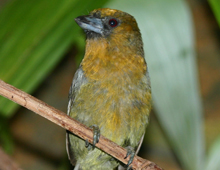Toucan Terrace

Ocellate river stingray, Potamotrygon motoro
While many of the 20 or so species of South American river stingrays have restricted ranges, this species is found in practically every river basin in South America. It is a popular species in aquariums because of its large orange spots. It can reach a diameter of two feet.
LEARN MORE
Prong-billed barbet, Semnornis frantzii
The 83 species of barbets are stocky woodpecker relatives found in Africa, Asia and the New World Tropics. The New World species are likely ancestral to the toucans. Found only in Costa Rica and Panama, this species has always been extremely rare in captivity. The specimens at the DWA were obtained through special permits from the Government of Panama.
LEARN MORE
Many-banded aracari, Pteroglossus pluricinctus
Compared to some other toucans, this species has a rather limited range in the north-western corner of South America, found in parts of Venezuela, Colombia, Ecuador, Peru and Brazil. It has never been common in zoos and was not bred in captivity until 2009, at the DWA, where specimens were received through the cooperation of the Venezuelan organizations PROFAUNA and FUNZPA. While it may appear bewilderingly similar to other aracaris, the two complete black bands across its chest distinguish it from any other toucan.
LEARN MORE
Humboldt’s lettered aracari, Pteroglosus inscriptus
Named for the pattern on its beak, the Lettered aracari has a larger South American range than its close relative, the Green aracari, but is much rarer in captivity. The first breedings outside of South America did not take place until 2010, when both the DWA and a private collection in California were successful. As with the Green aracari, males have black heads and females have brown heads.
LEARN MORE
Bare-faced curassow, Crax fasciolata
Found in a large area of Brazil, as well as Bolivia, Paraguay, and tropical Argentina, this has the southern-most range of the 14 species of curassows. All of these turkey-sized birds are considered delicious and subject to hunting pressure and most are of concern to conservationists. This species, however, is considered comparatively abundant, though no longer found in parts of its range. Rare in US zoos, it is widespread in European collections.
LEARN MORE

